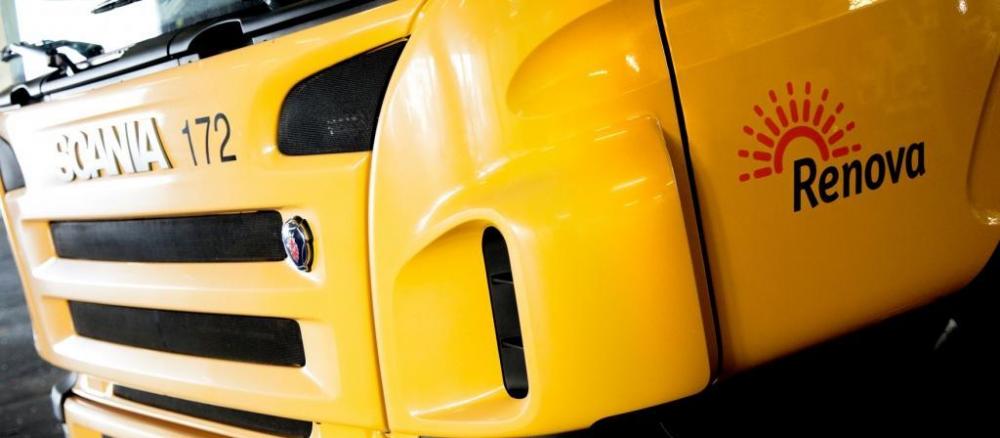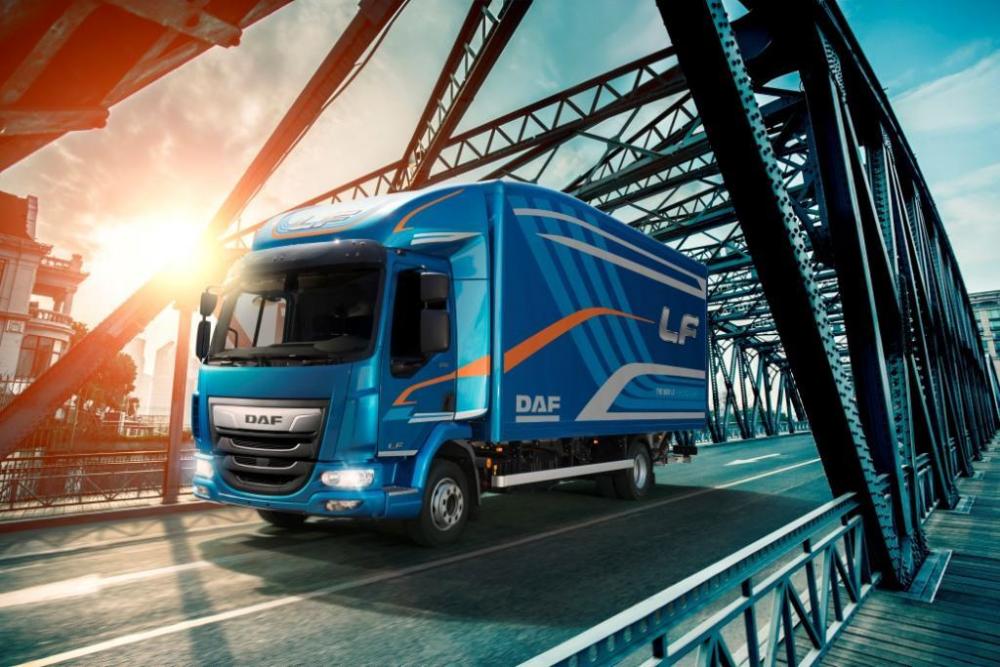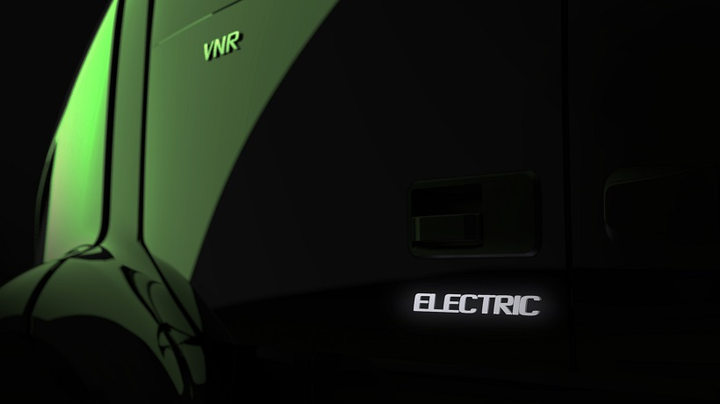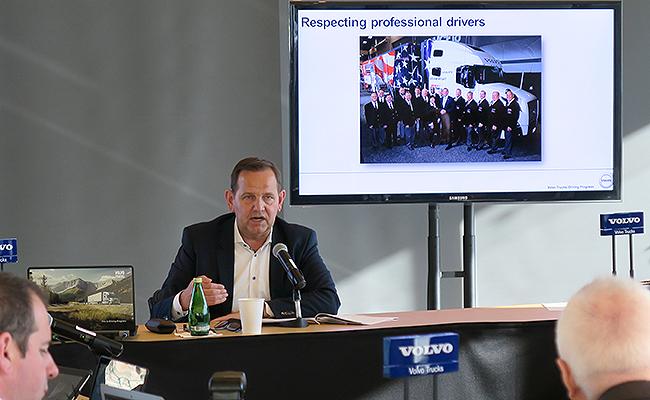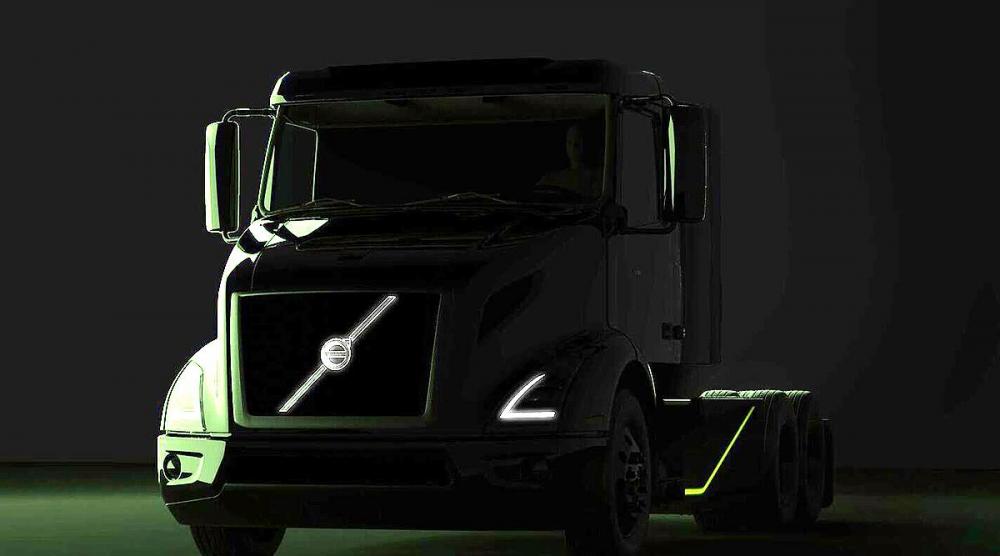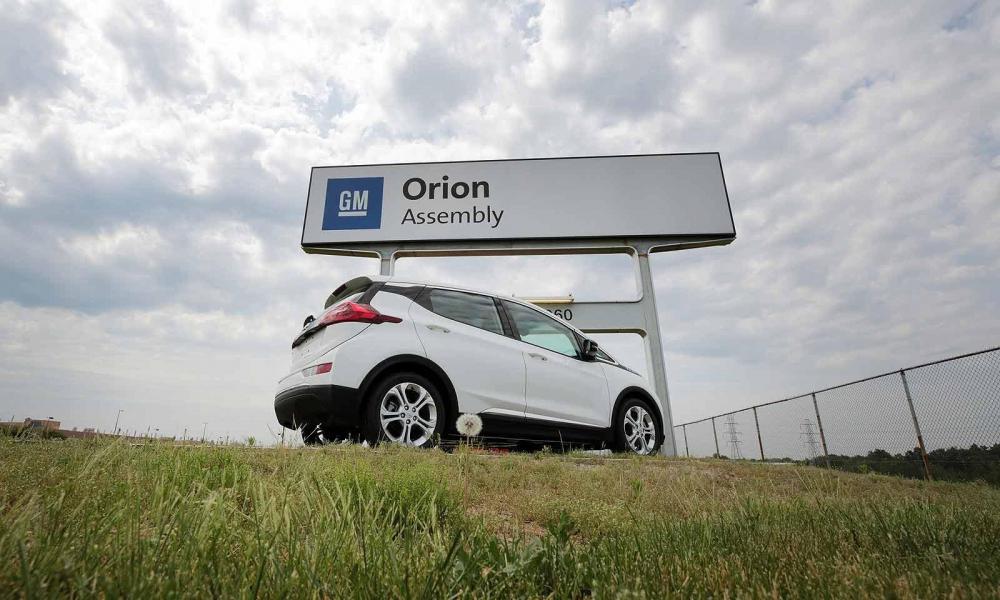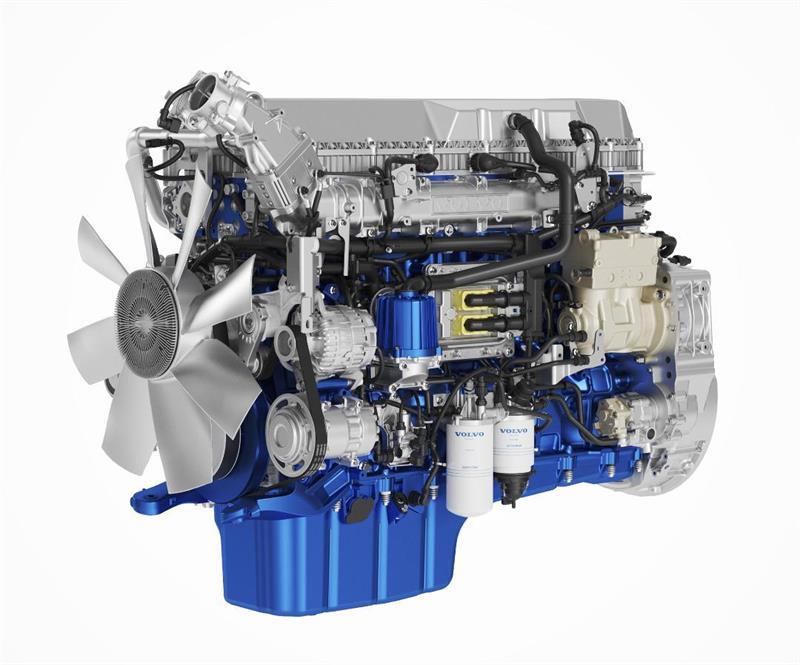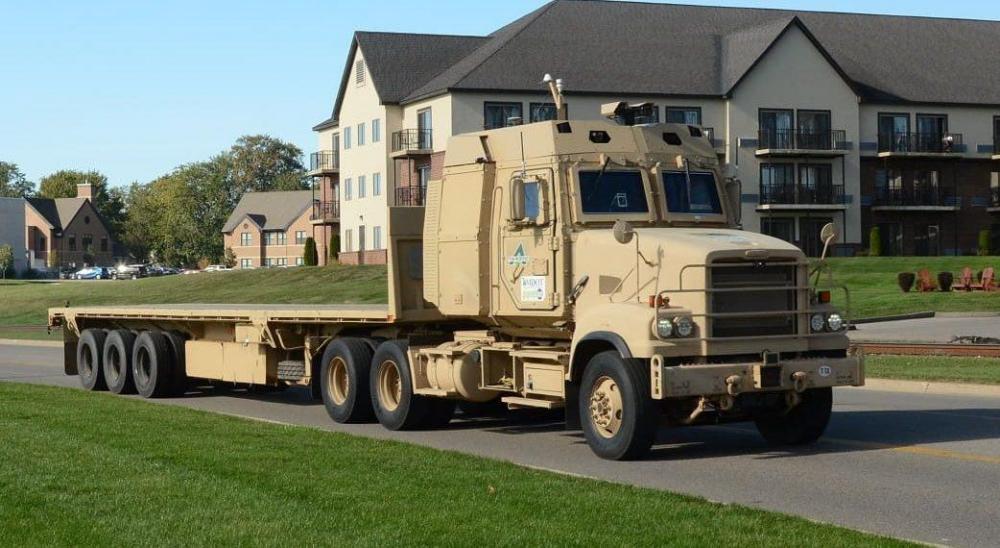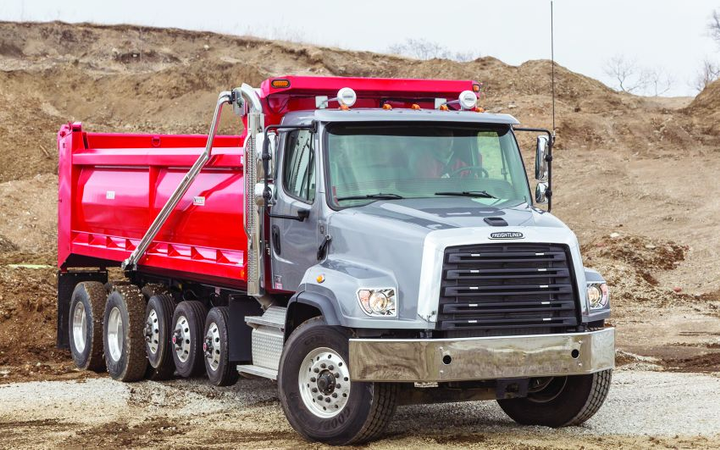
kscarbel2
Moderator-
Posts
17,891 -
Joined
-
Days Won
86
Content Type
Profiles
Forums
Gallery
Events
Blogs
BMT Wiki
Collections
Store
Everything posted by kscarbel2
-
Scania Group Press Release / December 10, 2018 Scania is developing a fuel cell refuse truck together with Renova, a waste handling company in western Sweden. The truck will feature a fully electrified powertrain as well as an electrified compactor. “We are highly interested in gaining more experience of fuel cells in actual customer operations,” says Project Manager Marita Nilsson, Electric Powertrain Technology at Scania. “Fuel cells constitute a promising technology in the needed decarbonisation of transports.” Refuse trucks often operate in residential areas in the early hours of the morning. With reduced emissions and noise, electric vehicles are especially attractive in these areas. Renova and other waste handling companies have previously carried out trials with electric refuse trucks but this will be the first with fuel cells. “Electrification using fuel cells fuelled by hydrogen is a highly appealing alternative for heavy commercial vehicles such as refuse trucks,” says Hans Zackrisson, Head of Development at Renova. “The trucks benefit from all the advantages of electrification while maintaining some of the best aspects of fossil-fuel operations, namely range, hours in service and payload.” Read more: Why hydrogen fuel cells could be one of the solutions for a future of sustainable transport The project is being implemented in cooperation with the Swedish Energy Agency and Stockholm’s Royal Institute of Technology and the fuel cell refuse truck is expected to be delivered in the end of 2019/beginning of 2020. Scania has previously announced that it is developing fuel cell technology in cooperation with the Norwegian food wholesaler Asko, which has opened its own production plant for sustainable hydrogen fuel. Scania is delivering four distribution fuel cell trucks with a range of 500 km to Asko. .
-
DAF Trucks Press Release / December 10, 2018 We wish you and your family the best. Enjoy the holiday season! .
-
DAF Trucks Press Release / December 10, 2018 For the second year in succession, DAF Trucks has scooped the British ‘Truck of the Year’ title for its market-leading DAF LF distribution range at the 2018 Commercial Fleet Awards. It’s already the fifth time DAF has received a top accolade in markets across Europe this year. Against stiff competition, the DAF LF emerged triumphant for its versatility, reliability, clear all-round appeal for fleet operators and DAF’s aftersales support. Judges said: “The LF retained its title as fleets again vote it their favourite truck. The LF’s versatility in urban environments is a defining feature, while its spacious cab and refined driving experience make it a firm favourite with drivers. Strong support from DAF, plus reliability and low running costs combine for an unbeatable package. DAF Trucks’ premium duty XF series – alongside the CF series – was primarily voted ‘International Truck of the Year 2018’ and subsequently received national Truck of the Year awards in Poland, Slovakia, Slovenia and Northern Ireland. “We’re naturally thrilled to win again,” said Richard Zink, Director Marketing and Sales and Member of the Board of Management of DAF Trucks, “and in the presence of such esteemed company. With the competition in this category, our LF has proved itself top truck yet again.” .
-
Navistar, UAW continue to work as contract details are negotiated
kscarbel2 replied to kscarbel2's topic in Trucking News
Navistar says it has tentative six-year deal with UAW Matt Sanctis, Springfield News-Sun / December 11, 2018 SPRINGFIELD — Navistar said today the company has a tentative six-year deal with members of the United Auto Workers, who are expected to vote Sunday on whether to ratify the contract. Company officials said the truck maker will not discuss any details of the contract before the Dec. 16 vote. Members of the UAW Local 402, which represents the majority of its workers in Springfield, could not be immediately reached for comment. “We are confident that this agreement will help us work as a team to competitively build our vehicles, run our plants and win in the market,” the company said in a statement on a website dedicated to the negotiations. This is the second time this month that members of the labor union will vote on a potential contract. The UAW voted Dec. 2 to reject a separate agreement. According to the UAW’s website, the union voted down that contract with 98 percent of the vote. -
Volvo Trucks to Introduce All-Electric Version of VNR Model
kscarbel2 replied to kscarbel2's topic in Trucking News
Volvo Reveals Electric VNR Model to Go On Sale in 2020 Heavy Duty Trucking (HDT) / December 11, 2018 Volvo Trucks has announced plans to sell an all-electric truck called the Volvo VNR Electric in North America by 2020. Volvo had already announced that they would begin testing all-electric trucks in regional haul fleets in California beginning in 2019 before selling an electric truck model 2020 but was light on the specifics. Now we know that the VNR Electric will be based on the fully-electric powertrain technology currently being used in the Volvo FE Electric, which Volvo Trucks presented in May and will begin selling in Europe in 2019. The company expects the VNR Electric to suitable for heavy urban distribution, drayage and other regional applications. “The Volvo VNR Electric leverages the versatility of the new Volvo VNR series with a proven fully-electric powertrain, and represents a strategic stride toward a comprehensive electrified transport ecosystem,” said Peter Voorhoeve, president of Volvo Trucks North America. “Cities prioritizing sustainable urban development can leverage electrified transport solutions to help improve air quality and reduce traffic noise. Cleaner, quieter, fully-electric commercial transport also creates opportunities for expanded morning and late-night operations, helping cut traffic congestion during peak hours.” The Volvo VNR Electric came out of the Low Impact Green Heavy Transport Solutions partnership between Volvo Group and California’s South Coast Air Quality Management District as well as transportation and electrical charging infrastructure members. The California Air Resources Board allotted $44.8 million for the Volvo LIGHTS project, which is part of an effort to reduce greenhouse gas emissions in California. . -
Volvo Trucks to Introduce All-Electric Version of VNR Model
kscarbel2 replied to kscarbel2's topic in Trucking News
Volvo plans VNR Electric regional tractor by 2020 Fleet Owner / December 11, 2018 WASHINGTON, D.C. — Volvo Trucks’ first North American all-electric truck will be a VNR regional-haul tractor, the company announced Tuesday. The trucks will debut in California as demonstration units next year, operating in distribution, regional-haul and drayage operations. The VNR Electric will go on sale in North America in 2020. “We are proud to announce the Volvo VNR Electric, designed to support cities focused on sustainable urban development and fleets operating in a range of regional-haul and distribution operations,” said Peter Voorhoeve, president of Volvo Trucks North America, during a meeting here with the media. “The Volvo VNR Electric leverages the versatility of the new Volvo VNR series with a proven fully-electric powertrain, and represents a strategic stride toward a comprehensive electrified transport ecosystem,” he said. “Cities prioritizing sustainable urban development can leverage electrified transport solutions to help improve air quality and reduce traffic noise. Cleaner, quieter, fully-electric commercial transport also creates opportunities for expanded morning and late-night operations, helping cut traffic congestion during peak hours.” The Volvo VNR Electric demonstration units will be based on the propulsion and energy storage technology currently being used in the Volvo FE Electric, according to the company, and builds on the Volvo Group’s accumulated expertise in electrified transport solutions. Sister company Volvo Buses has sold more than 4,000 electrified buses since 2010. “The Volvo VNR is ideal for applications like heavy urban distribution, drayage and other regional applications where electric trucks will first have the greatest impact,” said Johan Agebrand, Volvo Trucks North America director of product marketing. “The VNR series has received tremendous industry acceptance since its April 2017 introduction, and the addition of an all-electric powertrain provides even greater opportunities to expand its footprint in the regional-haul market.” Introduction of the Volvo VNR Electric models are part of a partnership, known as LIGHTS (Low Impact Green Heavy Transport Solutions) between the Volvo Group, California’s South Coast Air Quality Management District (SCAQMD), and industry leaders in transportation and electrical charging infrastructure. “The LIGHTS project is a truly unique opportunity to showcase a holistic approach to electrification of the freight transport industry as we handle ongoing challenges including electricity generation and battery optimization,” said Voorhoeve. “We appreciate that the California Air Resources Board (CARB) and the SCAQMD have recognized our leadership and trusted us to oversee this project that will ultimately result in the commercialization of fully-electric heavy-duty trucks. In addition to introducing the VNR Electric, through LIGHTS we will bring a complete sustainable freight solution with end-to-end electrification coordination with our many partners.” "Electric trucks bring many unknowns and our holistic focus through the LIGHTS project will help our fleet partners transition securely and smoothly based on their individual needs regarding driving cycles, load capacity, uptime, range and other parameters,” said Agebrand. “Within the project we’ll look at everything from route analysis and battery optimization to servicing and financing. We always aim to offer high uptime and productivity.” CARB has preliminarily awarded $44.8 million to SCAQMD for the Volvo LIGHTS project. The Volvo LIGHTS project will involve 16 partners, and will transform freight operations at the facilities of two of the United States’ top trucking fleets. Volvo LIGHTS is part of California Climate Investments, a statewide initiative that puts billions of Cap-and-Trade dollars to work reducing greenhouse gas emissions, strengthening the economy and improving public health and the environment – particularly in disadvantaged communities. -
Transport Topics / December 11, 2018 WASHINGTON — Volvo Trucks will bring electric-powered commercial trucks to North America next year by introducing a battery-electric version of its VNR regional haul model. The truck manufacturer said it will first deploy the zero-emissions VNR Electric tractor in 2019 in demonstrations in California and will begin selling the vehicle across North America in 2020. Volvo made the announcement here Dec. 11 during a roundtable discussion with industry press hosted by Peter Voorhoeve, the new president of Volvo Trucks North America. “We are proud to announce the Volvo VNR Electric, designed to support cities focused on sustainable urban development and fleets operating in a range of regional-haul and distribution operations,” said Voorhoeve, who began his current role Sept. 1. Volvo did not reveal the truck’s final design or the vehicle’s range and weight, but said it will be based on the battery-electric powertrain used in its FE Electric cabover model for the European market. The truck maker plans to deploy 23 of its VNR Electric models in southern California through a project dubbed Volvo LIGHTS, or Low Impact Green Heavy Transport Solutions. The project, aimed at reducing greenhouse-gas emissions, is a partnership between Volvo Group and California’s South Coast Air Quality Management District, as well as other companies involved in transportation and electrical charging infrastructure. The California Air Resources Board preliminarily awarded $44.8 million to SCAQMD for the initiative. Volvo LIGHTS will transform freight operations at facilities of NFI Industries and Dependable Highway Express, Volvo said. Voorhoeve described the project as an “end-to-end solution” addressing not just the vehicle, but the charging infrastructure and other concerns to make electrification work in real freight operations. “Electric trucks bring many unknowns and our holistic focus through the LIGHTS project will help our fleet partners transition securely and smoothly based on their individual needs regarding driving cycles, load capacity, uptime, range and other parameters,” said Johan Agebrand, VTNA’s director of product marketing. On the other side of the Atlantic, Volvo first unveiled the FE Electric and another all-electric model, the FL Electric, earlier this year, and announced plans to start selling those trucks in Europe in 2019. .
-
GM pressed by 2 Senators to build all EVs for U.S. stateside David Shepardson, Reuters / December 11, 2018 WASHINGTON -- Two U.S. senators from Ohio on Tuesday asked General Motors CEO Mary Barra to commit to building all future electric vehicles for U.S. buyers at home and to provide more details of plans to cut back on car production in North America. The letter from Republican Senator Rob Portman and Democrat Sherrod Brown demanding answers to questions by Dec. 21 is the latest effort by Congress and the White House to press GM into reversing its decision to halt production at four U.S. plants and cut thousands of jobs. The senators also asked if GM will produce additional EVs or shift to building EV SUVs and crossovers. The letter asks GM to disclose how many people at its suppliers in Ohio will lose their jobs if GM closes its Lordstown Assembly plant as well as how much it will cost to close the plant. GM plans to discontinue U.S. production of the Chevrolet Cruze, which is made in Lordstown. GM is unlikely to build a new vehicle at Lordstown once it halts Cruze production in March, company officials say, and GM executives have told Congress it would take two years or longer to develop and prepare the plant to assemble a new vehicle. Barra said last week she would keep an "open mind" about the plant's future. The final decision will be made during contract talks in 2019 with the United Auto Workers union, she added. On Friday, four members of the U.S. House wrote President Donald Trump inviting him to join them in visits to the closing plants and urging him to intervene "in every manner possible to seek both short and long term remedies for these workers." GM, which is holding a two-day board meeting this week, did not immediately comment on the letter. The company cut hundreds of contract product development jobs in Michigan last week as part of its plan to cut around 8,000 salaried positions in North America by early 2019. GM said in October 2017 it would launch at least 20 new all-electric vehicles by 2023, but has not said where they will be produced. GM builds the EV Chevrolet Bolt at a plant in Michigan, but plans to end production next year of its plug-in hybrid Chevrolet Volt in Detroit. GM builds the Buick Envision in China and exports it to the United States. The company asked the Trump administration in July to exempt the vehicle from a new 25 percent U.S. tariff. The White House favors ending the $7,500 EV tax credit. GM and Tesla Inc have been lobbying Congress to extend the credit to cover additional vehicles. .
-
Transport Engineer / December 7, 2018 Volvo Trucks is upgrading its D11 and D13 diesel engines for its FH, FM and FMX models, ahead of the introduction of the Euro VI Step D regulation. Claes Nilsson, president of Volvo Trucks, says the manufacturer has also used this opportunity to deliver new ways of reducing fuel consumption. “A combination of small improvements enables significant cost savings for our customers without compromising performance or productivity,” Nilsson says. Euro VI Step D focuses on ensuring that vehicles conform to the emissions standards in real-world operation – Volvo is achieving this with new engine software and improved coating in the exhaust after-treatment system. The upgraded D13 diesel engine (pictured) also uses a new VDS-5 low viscous oil type and new piston oil scraper rings to reduce fuel consumption and internal friction. Additionally, the 494bhp engine saves extra fuel by having the same higher compression ratio as the 454 and 415bhp versions. The upgraded engines are available to order from the end of this month. Volvo is also improving its I-See system with a new gear selection strategy and selective coasting, which enables a more efficient use of I-Roll, the freewheel function. “These updates will support our customers in staying on top of the new emission regulation while improving fuel efficiency for our Volvo FH, FM and FMX trucks,” says Nilsson. .
-
Defense Blog / December 10, 2018 The U.S. Army announced a plan to receive first autonomous vehicles for two transportation battalions by summer 2019, according to the article published in the January – March 2019 issue of Army AL&T magazine. A two U.S. Army’s transportation battalions will receive first autonomous leader-follower systems as part of advanced robotics programme. “The Ground Vehicle Systems Center’s work with the Robotic Operating System – Military (ROS-M) covers a spectrum of autonomy and robotics, including small explosive ordnance disposal-assist robots that have been fielded as part of the advanced leader-follower capabilities that Soldiers in two transportation battalions will see by summer 2019,” said the article . The ROS-M uses an open-source approach and a widely accepted software framework with common government and industry software to develop military robotics and autonomous systems. The open-source approach allows developers to create software modules for different applications and enables integrators to build modular systems using the best software modules available for military autonomous systems. Robotics helps Soldiers in two ways: It eliminates the need for Soldiers to conduct mundane, dangerous or repetitive tasks that can be automated, and it increases the standoff distance between Soldiers and a threat, which can greatly enhance safety. Additionally, automation can increase logistics on convoy missions. For example, a pair of Soldiers can operate a convoy that normally requires two Soldiers in each vehicle, freeing the additional Soldiers to conduct other missions, such as providing security for the convoy. Leader-Follower is still a limited form of autonomy — but those limits are more about Army tactics and culture than the technology itself. The U.S. Army is expected that autonomous systems and robots will take their place on the battlefields of the near future. They will be used in the more prosaic task of delivering ammunition and other supplies, freeing up more personnel to concentrate on warfighting tasks. The Army is ready for unmanned vehicles but not yet for a completely unmanned convoy, which is slated for a later phase of the Automated Ground Resupply program, albeit perhaps as early as 2022. .
-
Volvo Trucks North America (VTNA) / December 10, 2018 How do you make one of the most maneuverable trucks on the road even more nimble? Faster shifting, even better visibility and the best wheel cuts on the road — plus new seats and a revolutionary steering wheel. .
-
Heavy Duty Trucking (HDT) / December 10, 2018 Cummins has announced that the company’s lightest engine for Class 8 trucks, the Cummins X12, is now available for Freightliner’s 114SD chassis. Now available for order at Freightliner, the X12 engine weighs only 2,050 pounds and boasts up to 500 horsepower and 1,700 lbs.-ft. of torque. It has been optimized for the Freightliner 114SD chassis for vocational applications like concrete mixers and dump trucks. “Cummins is excited about the positive impact our X12 will have in weight-sensitive markets,” said Brett Merritt, vice president − Cummins on-highway engine business. “We believe that the Cummins X12 in Freightliner’s 114SD truck will be an exceptional option for vocational customers.” With its lighter weight, the Cummins X12 provides fleets with an option that can optimize productivity by reducing the unloaded weight of a vehicle while still providing suitable power for the job. Less weight can also mean more upfitting options, a benefit to both end customers and truck equipment manufacturer partners. The X12 also has a low-friction design for improved fuel economy and extended maintenance intervals similar to the Cummins X15 engine, as well as the company’s commitment to high mileage use and uptime. “By adding the Cummins X12 to our engine portfolio, we give the already versatile 114SD yet another option, showing our commitment to providing customers a choice,” said Kelly Gedert, director of product marketing for Freightliner Trucks and Detroit Components. .
-
Trailer-Body Builders / December 6, 2018 The Freightliner Custom Chassis Corporation (FCCC) product lineup features three lines of Class 4-8 chassis, including a front engine cowl/cab for S2G commercial trucks and front engine rail chassis for walk-in vans. The MT Gasoline, MT 45 Series and MT 55 Series chassis provide walk-in van options. FCCC said the Freightliner S2G custom chassis available for commercial propane truck conversions provides the only fully integrated, factory-installed fuel system with aftermarket support. The company uses hydraulic disc brakes from Walther EMC. The 4-millimeter-by-71-mm disc brakes feature a large pad volume for longer replacement intervals, pistons on each side of the rotor that apply force evenly, and linings without a clamp load to minimize drag. The Walther EMC brakes also feature a corrosion-resistant anti-lock braking system with a steel tone ring that resists heat breakdown. With a “no-flake” microstructure, the ABS teeth maintain integrity in corrosive environments and resist corrosion-induced ABS signal deterioration. A Detroit DD5 engine provides up to 11.9 mpg in parcel delivery applications, with an additional 12% fuel economy improvement when used together with Allison Transmission’s FuelSense 2.0 The engine also boasts efficient regeneration of the diesel particulate filter, optional integrated braking with up to 220 bhp, and the Detroit Connect Virtual Technician remote diagnostic system. Freightliner Custom Chassis last year introduced a line of non-diesel proprietary engines* developed for its chassis, and supported and serviced through its nationwide Freightliner dealer network. For the 2019 model year, the DriveForce 6.0L* gets a new engine control module with one common diagnostic connector, support for ADAS features that require engine de-torqueing and increased flexibility. The DriveForce 8.0L engine received several upgrades to address issues with rocker arms, PCV baffle, intake leakage, PTO filtering and reverse torque. Other enhancements include updates to the OptiView digital instrument cluster that provides situation-based information, minimizing distraction and optimizing efficiency, ProTek telematics and 24/7 Direct app. ---------------------------------------------------------------------------------------------------------------- * FCCC Unveils DriveForce Gasoline Engine in Louisville RV Business / November 28, 2017 Freightliner Custom Chassis Corp. (FCCC) is debuting DriveForce, its new line of proprietary non-diesel engines for the RV market at this week’s National RV Trade Show being held this week in Louisville, Ky. Developed exclusively for FCCC products, DriveForce will offer more options for dealers, OEMs and end-users, all while being supported and maintained by Freightliner’s nationwide dealer network and 24/7 direct customer service. According to a press release, the first engine in the DriveForce lineup showcasing in Louisville is the 6.0L gasoline engine. Offering 308hp and 367 lb.-ft. of torque, the first DriveForce engine will power FCCC’s MC chassis and offer a new high-quality, luxury chassis option in the 16,000-19,500 pound GVW product range. In addition, the 6.0L gasoline DriveForce engine will offer end-users increased fuel efficiency of up to 15% compared with current gasoline chassis available on the market. “We are incredibly excited to share DriveForce with the industry – and to continue to expand the number of world-class chassis products available to our OEM and dealer partners,” explained Gordie Taylor, RV product manager for FCCC. “We know from our extensive market and consumer research that DriveForce meets a growing need and, combined with the MC series, will offer an engine/chassis product unparalleled in its quality, performance and power to a growing segment of the market.” FCCC’s MC line features high-quality, world-class components intended to reduce maintenance intervals, increase chassis life and enhance the overall ride and handling experience. The MC’s premium WEMC Walther quad-piston hydraulic disc brakes offer commercial-grade braking power and provide five times the brake life compared with standard gasoline-chassis products. In addition, its one-piece frame rail provides superior durability compared to two-piece products currently available while a standard Allison transmission means five times less maintenance costs compared with current gasoline chassis on the RV market. SACHS shocks also help provide an overall premium driving experience. FCCC expects to have pilot units ready for development by early 2019.
-
Elon Musk Says Tesla Might Be Interested in Buying GM Plants Transport Topics / December 10, 2018 Elon Musk is sizing up General Motors' recently idled plants. The tech billionaire said in an interview with CBS’ “60 Minutes” that it’s “possible that [Tesla] would be open” to taking over automakers’ old plants, including factories GM recently has slated for closure. GM announced late November that it would idle assembly plants in Detroit-Hamtramck, Lordstown in Ohio and Oshawa in Ontario by the end of 2019. .
-
- 1 reply
-
- 1
-

-
I'd have to see the knob and HVAC assembly to be clear.
-
Navistar downgraded today to Sell from Neutral Goldman Sachs analyst Jerry Revich downgraded Navistar International to Sell and lowered his price target for the shares to $23 from $43. The analyst recommends an increasingly selective approach for the Americas Machinery, Engineering & Construction sector in 2019 amid growing signs of oversupply.
-
$140,000 new truck purchase
kscarbel2 replied to mojazzn's topic in Antique and Classic Mack Trucks General Discussion
A unique case, the C15 was available on CAT trucks in Australia because the country is Euro 5. But they are heading to Euro 6 and indeed many truckmakers are now selling Euro 6 product there anyway, including Scania. China is Euro 6 in the major cities and heading for nationwide soon. They're using Euro 6 tech to reach Euro 5, so the nationwide jump to Euro 6 will be a blink. The EU of course is Euro 6, where the trucks generally speaking have no issues. Remember EPA2007 and all the EGR issues? American Macks had windshield washer reservoirs melting under the hood. EPA2007 was the equivalent of Euro 5. EU operators had a choice of SCR or EGR. The Scania and MAN EGR trucks had no issues. -
In addition to the Scania-Vabis tag, is there a Mack tag? Being a DS, it should be turbocharged.....I'd assume it is a ENDTF475, rated at 216 horsepower. With the information off the Scania-Vabis tag, Scania North America could be of assistance. Are you related to former Mack Trucks Vice President Rick Kilgore?
-
$140,000 new truck purchase
kscarbel2 replied to mojazzn's topic in Antique and Classic Mack Trucks General Discussion
Yes, they are using it. The systems used in Europe and China for example (two of the three major truck markets), are generally trouble-free. One aspect of the US market is the low expected price point for trucks. The result is often cheaper systems with lower reliability. -
So it's a 1997 MS300P (straight truck) or MS300T (tractor). You didn't share the information off the engine data plate......I assume it says E3-220. Again, I'd call Volvo Group's Mack brand customer service at +1 (866) 298-6586 and tell them your dealer is unable and/or unwilling to assist you.
-
Marketwatch / December 10, 2018 The Paradox The Fed “should” raise rates because the economy is strong, near full employment, even though markets see early signs of a downturn. Nothing about the jobs report changes that — even though headline job gains were low, manufacturers added 27,000 jobs, suggesting that, despite General Motors’ GM, -2.83% big layoff announcement, the trade wars haven’t yet hit employment. Merrill still sees the unemployment rate falling to 3.2% next year as wages rise 3.5%. But the Fed “shouldn’t” raise rates because higher rates’ impact on housing would only worsen with more hikes. Friday’s consumer-confidence report from the University of Michigan says consumers’ expectations for future economic conditions are cooling off, which could be bad for everything from cars to restaurants. Interest rates are a big part of that. And because the unpredictable president and his off-and-on trade war aren’t getting any easier to figure out. The temptation is for monetary doves to say we told you so. If the Fed had moved more slowly, consumers would be more capable of picking up the slack as business investment stumbles on trade worries. It would be a better time for the Fed to raise rates, off of a lower base. But in the world we live in, the Fed has already made housing and cars more expensive, with the biggest risks from Trump still waiting to be quantified. In preparing for a Ghost of Recession (or Inflation) Future, it overlooked the bogeymen haunting 2019’s economy now. It’s going to be a muddle because the Fed has done too much already.
-
VW-Ford talks are gaining steam Michael Martinez, Automotive News / December 10, 2018 DETROIT — As Ford Motor Co. has tried to downplay its ongoing talks with Volkswagen Group, VW CEO Herbert Diess keeps upping the ante. Besides the potential for cooperating on commercial vehicles and sharing platforms for electric vehicles and pickups, Diess last week revealed that VW is eyeing access to Ford's U.S. manufacturing footprint, too. Since June, VW and Ford have been exploring a strategic alliance that could alter the global automotive landscape. Ford is looking to shed money-losing operations and streamline its work force, and sharing costs on redundant operations with VW would help speed that overhaul. VW, in turn, wants to increase its U.S. production and could use the help of an automaker well-versed in building the type of rugged SUVs and pickups that American buyers demand. After months of Ford demurring on any discussion of what the talks could produce, Diess' comments about using some Ford plants led Executive Chairman Bill Ford to acknowledge that something important might be budding. Ford said he didn't want to overstate the companies' progress but that the talks were going "really well." He added: "The culture fit is good." That's no small endorsement in an industry that has had all manner of alliances, partnerships and mergers collapse because the participants couldn't mesh. Ford, like many automakers, has been working to keep up with shifts in consumer behavior that threaten to upend the delicate balance between demand and manufacturing capacity. General Motors has too many underused plants, and Fiat Chrysler Automobiles is so maxed out that it might open Detroit's first new assembly plant in 27 years. Ford's phaseout of sedan production and shift to more light trucks has left it with some openings that VW could fill, but Diess' options are much more limited than they would be at GM. Most of Ford's U.S. plants are humming along at — and in some cases, over — ideal capacity. LMC Automotive says the automaker's North American utilization rate, including plants in Mexico and Canada, is at an impressive 81 percent. "We really manage that tightly," Ford CEO Jim Hackett told reporters last week. "I'm proud where we're at in our utilization right now." Both automakers declined to elaborate on Diess' comments, but factoring in what they have said about a potential tie-up, only three U.S. Ford plants — two in Michigan and one in Missouri — could realistically accommodate VW production. In June, the companies said their alliance would cover joint development of commercial vehicles for Europe. Diess later confirmed that VW was considering a global successor to its Amarok pickup based on Ford's Ranger, and Bloomberg has reported that the two may also collaborate on autonomous vehicles. 3 plants All of those actions involve operations at Ford's plants in Michigan and Missouri. The likeliest candidate to be involved is Michigan Assembly, which is newly converted to build body-on-frame Ranger pickups and Bronco SUVs. Jeff Schuster, LMC's president of global forecasting, said the plant's 400,000-unit annual capacity would leave room for more product even after the Ranger ramps up and Bronco output begins. It also would fill a weakness in VW's U.S. lineup. VW's Chattanooga plant builds the unibody Atlas crossover and the Passat sedan. VW is debating whether to offer its U.S. dealerships a small body-on-frame pickup based on the Ranger or a unibody pickup that would closely follow the Tanoak concept unveiled in March. Diess in November told Automotive News that a unibody pickup in the U.S. was "probably still a bit risky," but that the final decision would be up to VW's new North American CEO, Scott Keogh. Ford's Flat Rock Assembly Plant in suburban Detroit could be another option. It's the sole global source of the Mustang and Lincoln Continental, but Ford is cutting output to one daily shift in the spring because of weak demand. Even on two shifts today, Flat Rock has a utilization rate of only 49 percent, according to LMC. New product is on the horizon for Flat Rock, however. The site is getting a $900 million investment to build Ford's commercial autonomous vehicle slated for 2021. If VW wanted to partner on self-driving vehicles, that work likely would happen in Flat Rock. The Kansas City Assembly Plant in Missouri, running at just 63 percent utilization, also would make sense. It builds the F-150 and Transit, two huge players in the commercial-vehicle market in which VW is interested. Ford idled its Transit line for two weeks in October in response to slower commercial orders. Plenty of room Questions about possible plant sharing remain. VW has plenty of room at its North American plants, which are running at 71 percent capacity. It's unclear how much volume VW is looking to add, as well as what workers it would use. Any agreement presumably would require approval from the UAW, which has been trying unsuccessfully to organize VW's Chattanooga plant. Diess made his comments during a visit to the White House to discuss the company's U.S. ambitions, as President Donald Trump presses for more investment in manufacturing here. "I think there's certainly some political posturing — 'Look at us. We love the U.S.' — so I think it was done very deliberately around that meeting," Schuster said. "But coming from a German company that probably needs to be careful with what it says and does right now, I would be shocked if that was said without some substance behind it." ---------------------------------------------------------------------------------------------------- Capacity issues Shifts in consumer demand have made it harder for the Detroit 3 to keep their plants running efficiently. Ford could share some underused plants with VW, GM has too many car plants running inefficiently and FCA needs more capacity to make Jeeps. Plant 2018 utilization Ford Avon Lake 87% Chicago 152% Dearborn Truck 115% Flat Rock 49% Kansas City (van) 63% Kansas City (pickup) 102% Kentucky Truck 102% Louisville 91% Michigan 25% GM Arlington 138% Bowling Green 27% Detroit-Hamtramck 37% Fairfax 48% Flint 84% Fort Wayne 78% Lansing Delta Township 89% Lansing Grand River 33% Lordstown 30% Orion 34% Spring Hill 80% Wentzville 124% FCA Belvidere 95% Jefferson North 130% Sterling Heights 92% Toledo North 87% Toledo Supplier Park 9% Warren 46%
-
$140,000 new truck purchase
kscarbel2 replied to mojazzn's topic in Antique and Classic Mack Trucks General Discussion
I get what you're saying. Now that said, as an American who has sold trucks around the globe, I personally have come to care (find huge interest) in what is going on in all global markets. And, truth be told, the three largest global truck markets are converging. -
Investigation into generic "cartel" expands to 300 drugs Christopher Rowland, The Washington Post / December 9, 2018 Executives at more than a dozen generic-drug companies had a form of shorthand to describe how they conducted business, insider lingo worked out over steak dinners, cocktail receptions and rounds of golf. The “sandbox,” according to investigators, was the market for generic prescription drugs, where everyone was expected to play nice. “Fair share” described dividing up the sales pie to ensure that each company reaped continued profits. “Trashing the market” was used when a competitor ignored these unwritten rules and sold drugs for less than agreed-upon prices. The terminology reflected more than just the clubbiness of a powerful industry, according to authorities and several lawsuits. Officials from multiple states say these practices were central to illegal price-fixing schemes of massive proportion. The lawsuit and related cases picked up steam last month when a federal judge ruled that more than 1 million emails, cellphone texts and other documents cited as evidence could be shared among all plaintiffs. What started as an antitrust lawsuit brought by states over just two drugs in 2016 has exploded into an investigation of alleged price-fixing involving at least 16 companies and 300 drugs, Joseph Nielsen, an assistant attorney general and antitrust investigator in Connecticut who has been a leading force in the probe, said in an interview. His comments in an interview with The Washington Post represent the first public disclosure of the dramatically expanded scale of the investigation. The unfolding case is rattling an industry that is portrayed in Washington as the white knight of American health care. “This is most likely the largest cartel in the history of the United States,” Nielsen said. He cited the volume of drugs in the schemes, that they took place on American soil and the “total number of companies involved, and individuals.” The victims were American health-care consumers and taxpayers, who foot the bills for overcharges on common antibiotics, blood-pressure medications, arthritis treatments, anxiety pills and more, authorities say. The costs flowed throughout the system, hitting hospitals, pharmacists and health insurance companies. They hit consumers who lack prescription drug coverage and even those with insurance, because many plans have high deductibles and gaps on prescription drug benefits. In just one instance of extraordinary cost spikes, the price of a decades-old drug to ease asthma symptoms, albuterol, sold by generic manufacturers Mylan and Sun, jumped more than 3,400 percent, from 13 cents a tablet to more than $4.70. The example is documented in a lawsuit brought against the generic industry by grocery chains including Kroger. “Everyone is paying the price,” Nielsen said. He offered a single word to explain the behavior: “Greed.” While precise estimates of alleged overcharges have not been released, generic-industry sales were about $104 billion in 2017. Excessive billings of even a small fraction of annual sales over several years would equal billions of dollars in added costs to consumers, according to investigators. Generic manufacturers reject the accusations. They contend officials lack evidence of a conspiracy and have failed to prove anti-competitive behavior. Among the 16 companies accused are some of the biggest names in generic manufacturing: Mylan, Teva and Dr. Reddy’s. Mylan denied wrongdoing in an emailed statement. Sun, Teva and Dr. Reddy’s did not respond to requests for comment. In a court filing, Teva said allegations of a price-fixing conspiracy “are entirely conclusory and devoid of any facts.” But investigators say voluminous documentation they have collected, much of it under seal and not available to the public, shows the industry to be riddled with price-fixing schemes. The plaintiffs now include 47 states. The investigators expect to unveil new details and add more defendants in coming months, which will put more pressure on executives to consider settlements. Two former executives of one company, Heritage Pharmaceuticals, have pleaded guilty to federal criminal charges and are cooperating with the Justice Department in a parallel criminal case. A Justice Department spokesman declined to comment. The alleged collusion transformed a cutthroat, highly competitive business into one where sudden, coordinated price spikes on identical generic drugs became almost routine. Competing executives were so chummy they had an alphabetical rotation for who picked up the tab at their regular dinners, according to a person familiar with the investigation who spoke on the condition of anonymity because the case remains under investigation. Annual trade conferences and “Girls Night Out” cocktail meetings were other prime opportunities to swap sensitive information about markets and prices, according to court documents. “It’s particularly ironic since the whole idea of generic drugs was we would get a lower price,” said Henry Waxman, the Democratic former California congressman who co-wrote the 1984 law establishing the Food and Drug Administration’s rules for generics. “If generic versions are higher than need be through rigged systems, that undercuts the whole idea.” Generics account for 90 percent of the prescriptions written in the United States but just 23 percent of costs, according to the industry trade group, the Association for Accessible Medicines. And generic drugs do act as a check on soaring drug bills fueled by brand-name manufacturers. In the Medicare prescription-drug program, according to a government study, prices on a benchmark set of older generic drugs dropped 14 percent between 2010 to 2015. But for some generic manufacturers, the anti-competitive agreements drove up prices on most, if not all, of the products they sold, according to the states. Officials say they have documented price increases of up to 2,000 percent. Throughout 2013 and 2014, soaring generic prices sparked consternation at drugstores and among state and federal lawmakers. Independent pharmacists said they were dismayed to learn of the price-fixing allegations. “There’s old, old drugs that have been around a long time, and all of a sudden their price has increased by hundreds of percent and we don’t know why,” said J.D. Fain, owner of Pieratt’s Pharmacy in Giddings, Tex., a small town an hour drive east of Austin. Unlike the brand-name drug industry, which gets years of patent exclusivity for novel drugs, generic companies operate in a market that was designed to save consumers and taxpayers large sums through aggressive competition. When the FDA grants approval for a generic product, the first company in the door gets six months of exclusive rights to market the drug. The price discount from the brand-name product is relatively small, say 10 percent. Prices plunge as much as 50 percent once a second generic enters the market, the FDA has estimated. And by the time six or seven generic companies are competing on a particular drug, the price has declined 75 percent. Rigging the market has turned that model upside down for some drugs, state officials say. “It makes me angry,” said Eric Belldina, an operator of pharmacies in Masontown and Morgantown in West Virginia. “Most people think when their prices go up it’s because of a raw-ingredient shortage, not thinking the companies are sitting down, saying, ‘Hey, let’s do this.’ ” The states’ lawsuit contains particularly pointed allegations against Mylan and its president, Rajiv Malik, who is personally named as a defendant. Mylan faced public scrutiny in 2016 for raising the price of its EpiPen, to treat allergic reactions, by about 500 percent. Although the EpiPen was not a generic product at the time, the outcry from physicians, patient groups and members of Congress drew negative attention to the second-largest generic manufacturer. While traveling in the United Kingdom in 2013, Malik took a phone call from an executive of a competing firm, Heritage, the states say in their lawsuit. Heritage had won FDA approval to market a version of the antibiotic doxycycline called Doxy DR, which is used to treat acne and a long list of infections. That would put it in direct competition with Mylan for sales of the drug. During the transatlantic phone call, Malik and the Heritage executive, Jeff Glazer, agreed to divide up the sandbox, the U.S. market for sales of Doxy DR, according to the lawsuit by states and similar complaints by independent pharmacies and grocery-store chains. During subsequent conversations, according to the complaints, Mylan agreed not to sell Doxy DR to CVS and the wholesaler McKesson — sales volume worth about 30 percent of the U.S. market for the drug. As part of the alleged deal, Heritage agreed not to set a low price. Without a reduction in price, U.S. consumers ended up the biggest losers in the deal. Mylan said it has no evidence its executives did anything wrong. “We have been investigating these allegations thoroughly and have found no evidence of price fixing on the part of Mylan or its employees,” the company said in a statement. “Mylan has deep faith in the integrity of its president, Rajiv Malik, and stands behind him fully.” Heritage did not return repeated phone messages. Glazer and another Heritage executive, Jason Malek, pleaded guilty in 2017 to federal charges of conspiring to rig prices and stifle competition. The terms of their plea agreements said they are cooperating with a Justice Department criminal probe. A drug to treat bone issues related to cancer, zoledronic acid, was the subject of another alleged price-fixing scheme, this time between Heritage and Dr. Reddy’s. Heritage became the first generic manufacturer of the drug in the spring of 2013, but Dr. Reddy’s was close behind. Executives at the companies cut deals so each got a “fair share” of the market, while also conspiring to fix an inflated price, the complaints said. Dr. Reddy’s, which did not respond to requests for comment, wound up with about 60 percent of the market and Heritage claimed 40 percent, according to the states’ lawsuit. Investigators cited evidence that executives knew they were acting illegally. As the discussions with Dr. Reddy’s took place, according to the complaints, a Heritage executive “sent a text message to his entire sales team reminding them not to put their pricing discussions with competitors in writing.” Mysterious price spikes continue to roil pharmacies and patient groups occasionally, though widespread price collusion was curtailed after authorities issued subpoenas in recent years, said Michael Cole, a Connecticut assistant attorney general actively involved in the case. But many drugs remain at artificially inflated prices. “There have not been rollbacks in the price increases,” he said. “We’re still paying.”
BigMackTrucks.com
BigMackTrucks.com is a support forum for antique, classic and modern Mack Trucks! The forum is owned and maintained by Watt's Truck Center, Inc. an independent, full service Mack dealer. The forums are not affiliated with Mack Trucks, Inc.
Our Vendors and Advertisers
Thank you for your support!


